I . Survey
(i) Geographical Position
This is the beautiful and richly endowed Heilongjiang, a province named after its largest River, the Heilongjiang River.
Heilongjiang faces Russia across the Heilongjiang River in the north and the Wusuli River in the east, and shares a borderline of over 3,045 kilometers with Russia, As China's sixth largest province, Heilongjiang covers 454,800 square kilometers, accounting for 4.7 percent of the nation's total land area. Heilongjiang province exercises jurisdiction over 13 cities (prefectures), 65 counties (county-level cities) and ethnic autonomous counties, with Harbin as its capital.
(ii) Natural Resources
The Province features a rigid temperate continental monsoon climate with annual average temperature from minus 4 to 4 degree centigrade. The frost-free period is 100-140 days, and its precipitation is 450-650mm.
(iii) Population and nationalities
As of 2005, the total population of the province was 38.168 million. Besides Han, there are 48 minority groups, such as Manchu, Korean, Mongol and Hezhe.
(iv) Infrastructure Facilities and Communications
Communications
In terms of communications and transport, a comprehensive network of land, water and air, in parallel with the pipeline system, has been established. At present, there are 5,464 kilometers of railways in operation, making Heilongjiang one of the regions with higher railroad density in China, The main road network has been formed linking up major cities in the province with high-class roads in the shape of' OK' and featured by' one ring and five extensions'. The total mileage of roads in Heilongjiang is 67,076 km, including 958 km of highways, 1,118 km of first-class roads and 7,140 km of second-class ones, In terms of water transport, the water transportation network have been established with Heilongjiang River, Songhua River as the mainstay and open ports and with Harbin, Jiamusi, Heihe and Tongjiang and with the key ports, with totally 5,057 km of navigation river way in the province. There are 5 civil airports in Harbin, Qiqihar, Mudanjiang, Jiamusi and Heihe, with all their flight zones above class 4c. To date, Heilongjiang has established 59 air routes, of which 7 are international air routes.
Telecommunication and Internet
The telecommunication network of Heilongjiang is up to the world advanced level, with Harbin as the hub linking up the whole country and the outside world. At present, the total length of the optic fiber cables is 42,663 kilometers in length. Hence, a modern telecommunication framework has been formed, with the optic fiber network as mainstay and microwave network as the auxiliary. Furthermore, the services of program-communication and digitalized transmission have been made available in areas above the township level.
Currently, the communication network system in Heilongjiang is adequate to provide complete, multi-leveled and high quality services, and materialize full coverage in terms of population, territory, and service types. At the end of 2005, there were 10.822 million telephone subscribers, 11.323 million mobile phone subscribers and 1.659 million internet users.
Finance and Insurance
At present, there are over 6,000 banking outlets and 100,000 employees in banking industry in Heilongjiang province. A complete financial service structure has been formed in the province offering banking, security and insurance service and strongly support the social and economic development in local areas. By the end of 2005, the total deposit balance of foreign currency and RMB in Heilongjiang's financial institutions amounted to RMB 625.64 billion while the total loan balance amounted to 372.46 billion. Within the province, there are 38 public companies in both domestic and foreign security markets which have totally raised RMB 20.5 billion.
There are 12 insurance companies in Heilongjiang province. In 2005, the total insurance policy income hit RMB 12.764 billion yuan.
Main Banking Institutions
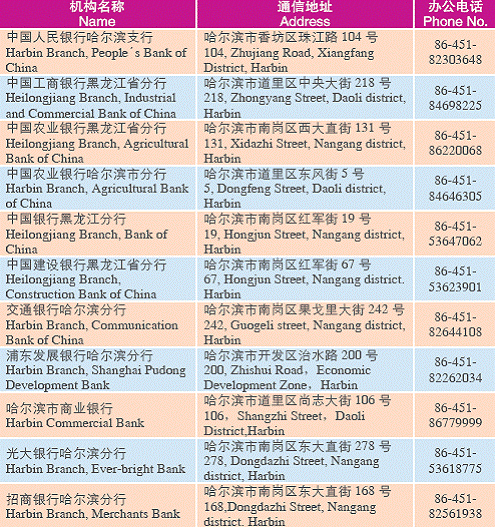
Main Insurance Institutions
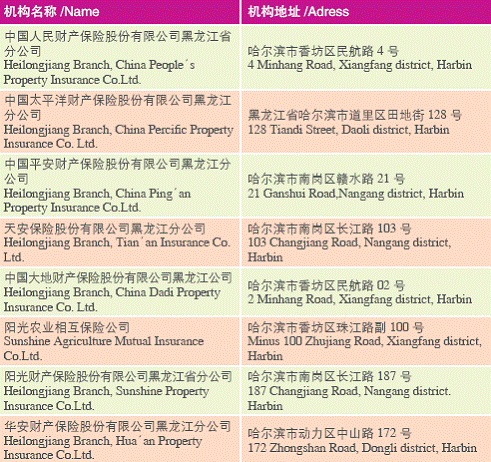
(v)Foreign Exchanges
Located in the center of Northeast Asia and the s tarting point of Euro-Asian continental brige, Heilongjiang has established river-sea and land-sea through transport leading to Russia, Japan, DPRK and ROK. The province shares a common borderline of over 3,045 km with Russia and has 25 state first-class ports and 3 mutual trading zones with Russia.
Ever since the reform and opening-up of China ,Heilongjiang has formulated the strategy of' allying with the south and opening up to the north'.Its opening-up keeps expanding and the international exchanges are becoming more and more frequent. Up to now, Heilongjiang has established twinning relationship with 16 provinces (oblasts, states, counties and prefectures) and 51cities of 18 countries.
Table of Sister Relationships of Heilongjiang Province
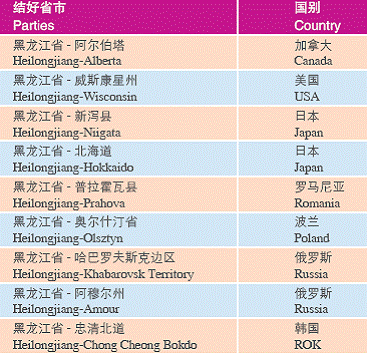

Convention & Exhibition
In addition to its bilateral contacts, Heilongjiang is actively committed to multilateral exchanges and collaboration. The province has organized 17 sessions of China Harbin International Fair for Trade and Economic Cooperation, and hosted the Northeast Asia Regional International Seminar on Social Development & Soluition, International Workshop on Skiing Industry, the Northern Forum General Assembly, the Northeast Asia Regional Governments Conference, and other major international events.
(vi)Higher Education and Scientific Research
Recent years have witnessed constant uplifting of scientific and technological innovative capabilities and rapid development of the hi-tech industry, which has gradually constituted a new force in promoting social development of the whole province. Heilongjiang ranks among the top places in the nation in terms of regional innovative capabilities and comprehensive scientific ' technological string and the seventh in China in human resources of science and technology.
Heilongjiang possesses a number of research institutes with great technological strength in petrol-chemistry, bio-pharmacy, information technology, electromechanical integration, new materials and new energy, crops breeding and cultivation, dairy processing, as well as aerospace industries. Up to 2005, there are 605 scientific research and development institutions in Heilongjiang province with 1,009 major scientific achievements, 6,050 applied patents 2,906 authorized patents. Some of the scientific achievements have been applied in China's key projects such as the three-gorges power plant, the 2008 Beijing Olympic Games, Qinghai Tibet railroad, the West-to-East Gas Transmission project, South-to-North water transmission project and Shenzhou Spaceship building. Some of the achievements hold leading position in China even in the world.
Currently, there are over 100,000 scientific research personnel in the province, of which 71,000 are scientists and engineers working in universities, research institutions and industrial enterprises. In addition, there is a large number of well- trained works as well.
(vii)Tourism
As one of the 'national ecological model provinces', Heilongjiang has in place 9 national nature reserves, 16 provincial nature reserves and 37 national forestry parks, Heilongjiang boasts abundant and unique tourist resources with clear seasonal distinction and is reputed as 'cool Province' in china. It is renowned for immense ice and snow, large forests, vast wetlands, big border rivers, large lakes, modernized farming as well as volcanic landscape, urban sceneries, minority folkways and cross-border tourism. Namely, the Jingbo Lake, Wudalianchi (Five-Connected-Lakes), Xingkai Lake, Yichun National Forest Park, Yabuli Ski Resort, Longzhu Erlong Mountain Ski Resort, Jihua Changshou Mountain Ski Resort, Harbin Grand World of Ice and Snow, Ice and Snow Sculptures Show and Ice Lantern Show have all become the renowned summer and winter tourist attractions in China.
II. Economy
(i)GDP Data
In 2005, total GDP in Heilongjiang province reached RMB 551 billion Yuan. The GDP per capita in the province is RMB 14,430 Yuan, equivalent to USD 1,762. The proportions of its primary, secondary and tertiary industries are respectively 12.2%, 54.9% and 32.9%.
Composition of the Primary, Secondary and Tertiary Industries of Heilongjiang Province(%)
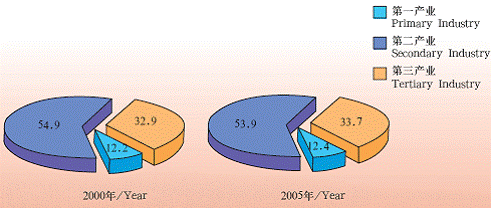
(ii) Data on Resources, Industry and Agriculture
Land Resources
Heilongjiang currently possesses 9.905 million hectares of cultivated land, with higher soil organic substances than other provinces since it is located in one of the three world-famous dark soil belts. The main crops are soybean, wheat, corn, potato and rice, while the main cash crops include sugar beet, flax and tobacco, etc.
In the province there are 65 million hectares of grassland, growing high quality and nutritious grass, which is ideal for developing animal husbandry; the Songnen plain is ranked among the three largest sheep pastures in the world.
Forest Reserves
As one of the country's largest forestry provinces, Heilongjiang is an'ecological demonstrate province', which is being constructed by Chinese government. With its forest coverage rate at 43.6 %, the province has a forestry operation area of 31.75million hectares, accounting for 69.8% of the province's land areas. Heilongjiang's reserves of living trees are up to 1.5 billion cubic meters, ranking the first place in China in terms of total forest-covered area, total timber reserves as well as wood output volume. Heilongjiang is the nation's major state-owned forest region and the largest timber production base with up to 100 species of trees, of which about 30 are of higher value.
Water Resources
There are many rivers and lakes within the territory of Heilongjiang province. Its five major water systems include Heilongjiang river, Wusuli River, Songhua River, Nen River and Suifenhe river. In addition, there are over 6,000 lakes and reservoirs, and the total water surface area is up to 800,000 hectares. Heilongjiang is abundant in water resources, with 70 percent of rainfall concentrated in the growth period of crops, thus, sufficient precipitation plus proper heat constitute a favorable climate for plants.
Mineral Resources
Heilongjiang is a major mineral resource-based province, with 132 varieties of minerals found and the reserves of 78 kinds verified. The reserves of oil, graphite, Sillimanite, basalt, marble, potassium feldspar ranks the first place in the nation. The coal reserves take the lead among the three provinces in Northeast China. 62kinds of minerals have been developed and utilized.
Resources of Wild Lives and Native Produce
There are 476 species of wild animals in the province, of which 17 species are subject to state first-grade protection such as Siberian tiger, red-crowned crane and white crane; 66 species like red deer, black bear and swan fall under the nation's second-grade protection. There are 105 species of aquatic produce in the province, like the dog salmon, a kind of unique produce in the frigid region. And there are over 1,000 varieties of local products and mountain produce. Local growing plants for medicinal usage are of 856 species, 387 genus and 108 families, of which famous medicinal herbs inclued ginseng and acanthopanax, etc.
Industry
As one of China's old industrial bases, Heilongjiang is the country's major producer for energy, timber, industrial equipment and chemical raw materials. Along with the deepening of industrialization process, a relatively complete industrial system has been established, with heavy industry as the mainstay, with large enterprises as the backbone. The system focuses on industries such as machinery, metallurgy, power, petrol-chemistry, coal mining, forestry, construction materials, pharmacy, food processing, light-industry, and textile. The system plays a significant role in China's industrial layout. Heilongjiang takes the leading position in the country in manufacturing of large pressure vessels, large mining equipment, complete sets of large power plant equipment, heavy-duty tandem rolling and continuous casting equipment, nuclear power facilities, heavy-duty NC machine tools, large combined harvesters, freight trains, automobiles and engines, multipurpose aircrafts, helicopters, regional aircrafts, large castings ' forgings, precision bearings and NC machine tools and measuring tools. The output volume of major products such as timber, crude oil, natural gas, raw coal and dairy products ranks among the first in the country.
Industrial Data
In the year of 2005, profit and tax created by industrial enterprises above designated size was 146.77 billion Yuan. The comprehensive index of industrial economic efficiency was 333.2.
The accelerating development of the 'six major bases' contributes over 95% of total industrial economic growth in the province. The total industrial output value of the six bases, namely, assembling industry, petrol-chemistry, energy, food, pharmaceutical and wood processing has reached 438,38 billion Yuan.
Output Value of the Six Major Bases
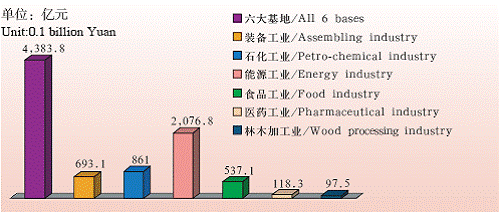
Output of Main Industrial Products of Heilongjiang Province in 2005
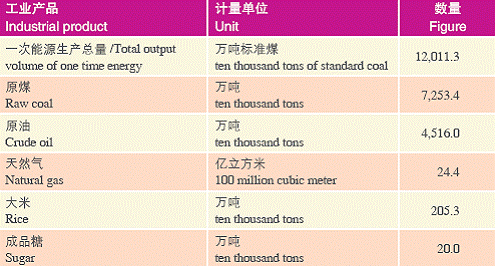


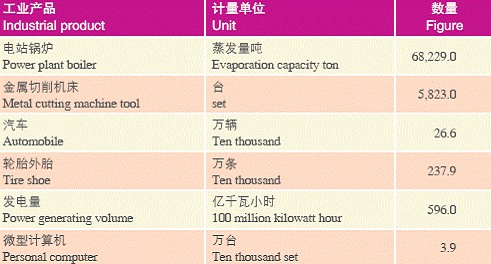
Agriculture
Heilongjiang is the nation's major grain producing area and commodity grain base, with years of development, five major agribusiness industries have come into being.
Grain Production
Heilongjiang is characterized by vast concentrated farmland and fertile soil. Its grain production has always been the fundamental industry of the province. The plantation area and yield of soybean, corn and rice rank the top places in the country. In 2005, Heilongjiang enjoyed another bumper harvest, with the total grain yield up to 36 million tons, creating another historical high.
Animal Husbandry
With large prairies and rich resources of crops straws, and with dairy cattle as the mainstay, animal husbandry in Heilongjiang is developing rapidly and has a tremendous potential for further development. The dairy cattle in stock and fresh mild output rank the first place in the country. The production of meat, eggs and milk keep increasing by a big margin. The output value of animal husbandry alone was 46 billion Yuan in 2005, accounting for 40% of total output value of agriculture, animal husbandry and fishery, making Heilongjiang a major province of animal husbandry in China.
Green Food Industry
Featured by green mountains, clean waters and unpolluted land, Heilongjiang is quite suitable for developing green food, organic food and pollution-free food. Green food has become the top image of new industries in Heilongjiang province. 324 green food production bases have been established in the province. The total plantation area of green food amounts to 2.327 million hectares while that of organic food amounts to 120.7 thousand hectares. The breeding volume of green livestock and poultry amounts to 12.86 million heads and the total production amounts to 15.81 million tons. With a total output value of 40 billion Yuan and 900 authenticated products, the province has become the largest green food production base in China.
Agricultural products processing
There are 1,050 enterprises specializing in the processing of agricultural products, which have benefited 1.6 million households of farmers as well as plantation bases with total area of 3.533 million hectares. The number of backbone processing businesses is still growing.
Development of Mountain Specialties
Great efforts have been made in developing mountain specialties such as pine nuts, hazel nuts, black fungus, hazel mushroom, ginseng, antler, acanthapanax, wild vegetables like brake tender leaves and vetch. The annual output of these specialties is more than 600,000 tons.
(iii) Data on Commerce
Import and Export Business
In the year of 2005, total import and export volume of Heilongjiang province reached USD 9.57 billion, increased by 40.9% over the precious year. The export volume was USD 6.07 billion while the import volume was USD 3.5 billion, increased by 64.9% and 12.6% respectively over the last year. The export volume to Russia market amounted to USD 3.84 billion. At the same time, export to Korea, USA and EU also enjoyed increase at different rate.Depending on its unique geographic advantage, Heilongjiang province has made great achievements in opening up to the outside world with Russia, Japan and Korea as key trade and cooperative partners. Heilongjiang province has kept the top position for many years among provinces in China in term of trade with Russia. Up till now, Heilongjiang has established trade ties with more than 130 countries and regions in the world with export commodities reaching over 4,000.

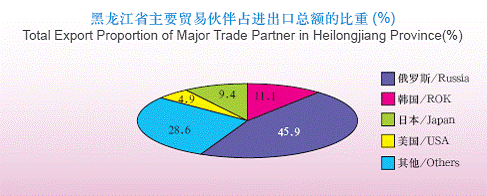
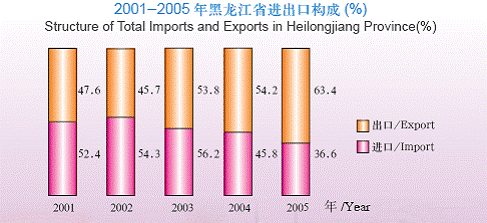
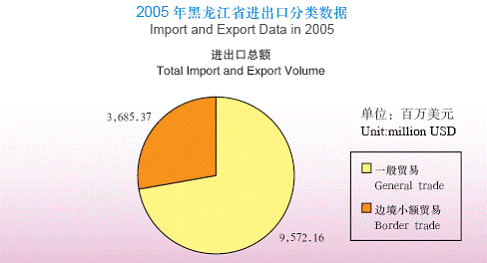
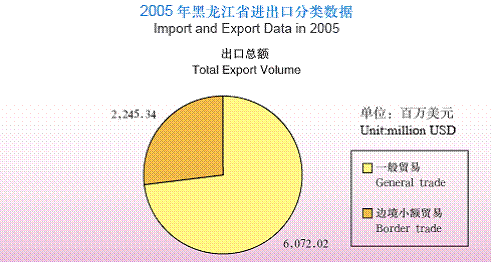
Utilization of Foreign Direct Investment
In 2005, total FDI in Heilongjiang province amounted to USD 1.52 billion. The newly approved foreign direct investment projects reached 266, contracted foreign direct investment reached USD 1.975 billion, and FDI actually used reached USD 1.447 billion. 23 of the Fortune World Top 500 businesses have their investment in Heilongjiang.
Foreign Economic Cooperation
In 2005, Heilongjiang province singed 185 contracts on foreign economic cooperation projects including contracting engineering project and labor service projects with total contracted value of USD 450 million. For direct investment abroad, 54 new contracts were signed with total investment of USD 430 million including USD 390 million Chinese direct investment and 30 projects over USD 1 million. Helongjiang's investment covered 38 countries and regions.
Commodity circulation

III. Investment
(i)Policy and Administrative Rules
Catalogue of Related Laws
Foreign Trade Law of the People's Republic of China
Customs Law of the People's Republic of China
Law of the People's Republic of China on Import and Export Commodity Inspection
Law of the People's Republic of China on Chinese-Foreign Equity Joint Ventures
Law of the People's Republic of China on Chinese-Foreign Contractual Joint Ventures
Law of the People's Republic of China on Foreign-Capital Enterprises
Company Law of the People's Republic of China
Law of the People's Republic of China on the Entry and Exit Animal and Plant Quarantine
Law of the People's Republic of China on Control of the Entry and Exit of Aliens
Law of the People's Republic of China on the Control of the Exit and Entry of Citizens
Securities Law of the People's Republic of China
Income Tax Law of the People's Republic of China for Enterprises with Foreign Investment and Foreign Enterprises
Individual Income Tax Law of the People's Republic of China
Law of the People's Republic of China on the Administration of Tax Collection
Environmental Protection Law of the People's Republic of China
Law of the People's Republic of China on Evaluation of Environmental Effects
Law of the People's Republic of China on Promotion of Cleaner Production
Law of the People's Republic of China on Prevention and Control of Desertification
Marine Environment Protection Law of the People's Republic of China
Law of the People's Republic of China on the Prevention and Control of Atmospheric Pollution
Law of the People's Republic of China on Prevention and Control of Environmental Pollution by Solid Waste
Law of the People's Republic of China on Prevention and Control of Water Pollution
Law of the People's Republic of China on Prevention and Control of Environmental Noise Pollution
Law of the People's Republic of China on Prevention and Control of Radioactive Pollution
Frontier Health and Quarantine Law of the People's Republic of China
Labour Law of the People's Republic of China
Trade Union Law of the People's Republic of China
Searching Website for the Related Laws
1. Searching System of Laws and Regulations of China (website of National People's Congress of China)
http://law.npc.gov.cn:87/home/begin1.cbs
2. China Legislative Information Network System
http://www.chinalaw.gov.cn/jsp/jalor/index.jsp
3. Ministry of Commerce
http://www.mofcom.gov.cn
The above-mentioned websites are for reference only.
(ii) Key Industries with Priority
1. Linen textile industry.
2. Development of subsequent industries after adopting the nation's key ecological projects such as returning farmland to forestry and protection project of natural forests.
3. Development and utilization of water-saving irrigation technology.
4. Research, development and utilization of coal processing technology.
5. Intensive processing of graphite products.
6. Production of Chinese traditional pharmaceuticals in forms of frozen dry powder preparation.
7. Manufacture of electrical instruments and intelligent management and controlling system of power grid.
8. Build and operation of urban gas, heat and water supplying (drainage) networks.
9. Development of winter tourism resource and forest resource.
10. Development, construction, protection and operation of tourism scenic spots & facilities.
11. Highway passenger transportation.
(iii) Procedures for Establishing foreign funded enterprises
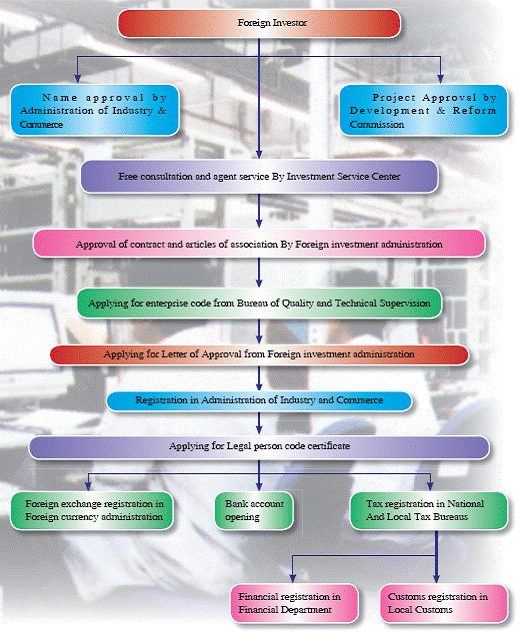
(iv) Rules of Employment
Foreign funded enterprises are free to decide on the organization structure the and the size of human resource as well as time, number, condition and methods for recruitment. In line with the Labor Law of the People's Republic of China as well as other relative laws and regulations, Foreign funded enterprises should sign contract with employees and register in Labor and Social Security Department. Enterprises are obligated to pay social insurance and other social welfare fees for their employees. Enterprises are free to fix the salary standard for their employees. However, it should not be lower than the minimum local standard. It is forbidden to recruit child worker or to arrange female worker to conduct illegal work. Employees of FFEs enjoy leaves for festivals, vacations, public holidays, visiting parents or spouses and handling marriage or funeral affairs.
(v) Living Environment
Visa and residence permit
Senior foreign talented persons and investors, by submitting relevant certificates, can obtain F visa valid for 2-5 years with multi-entrance or residence permit for 2-5 years. Foreigners who are in important position of Chinese key enterprises or organizations, who have made outstanding contribution to China and who have great investment in China, his/her spouse and unmarried children under the age of 18 can also apply for permanent residence permit. Residence permit or permanent residence permit bearers are exempted from going through visa formalities.
Directions for Foreigners Employed in Heilongjiang
In accordance with Stipulations and regulations for foreign employees in China, the government applies employment permit administration over foreigners employed in Heilongjiang province. The procedures for applying such permit are as follows:
1. The employer when intending to employ a foreigner'stall fill out the Application Form for the Employment of Foreigners and submit it to its competent trade authorities at the same level and the labor administrative authorities together with the following documentations'
the curriculum vitae of the foreigner to be employed'
the letter of intention for employment'
the report of reasons for employment'
the credentials of the foreigner required for the performance of the job'
health certificate of the foreigner to be employed;
other documents required by regulations'
2. The labor administrative authority should take into consideration of the opinions of the competent trade authorities and the demand and supply of labor market'and issue the Employment License to the employer after examination and approval.
3. Employers with permission to employ foreigners shall not send the Employment License nor the letter of visa notification directly to foreigners to be employed and they must be sent by the authorized unit in our province.
4. Foreigner with permission to work in our province should apply for Employment Visas (Z) at the Chinese embassies' consulates and visa offices, bringing with them the Employment License issued by the Ministry of Labor and Social Security'the letter or telex of visa notification sent by the authorized unit and the valid passport or Travel Document.
5. The employer should, within fifteen days after the entry of the employed foreigner take to the original Certificate Office the Employment License the labour contract with the said foreigner and his passport or Travel Document to receive his Employment Permit while filling out the Foreigner Employment Registration Form.
6. Foreigners who received their Employment Permit should'within thirty days after their entry'apply for the residence certificate with the public security organs bringing with them their Employment Permit. The term of validity of the residence certificate may be determined in accordance with the term of validity of the Employment Permit'
7. Foreigners who have not been issued residence certificate (i.e. holders of F'L'C or G-types visas)'and those who are under study or interim programs in China and the families of holders of Employment Visas shall not work in China'In special cases'employment may be allowed when the foreigner changes his status at the public security organs with the Employment License secured by his employer in accordance with the clearance procedures. Under these Rules foreigners changes his status at the public security organs with the Employment License and receives his Employment permit and residence certificate'
Urban living environment
Harbin, the capital city of Heilongjiang, is the political, economic and cultural center of the province. At the beginning of last century, more than 200,000 foreign immigrants used to live in the city. So the townscape, architectural style and living custom are deeply influenced by western culture. So it is also called Oriental Moscow' and' Oriental Paris. Harbin is quite developed in trade and commerce. World retail giants such as Wal-Mart, Carrifour, Metro and some other well-known retail chain businesses at home and abroad have settled in the city serving thousands of commodities with convenient shopping facilities. So far as catering industry is concerned, one can enjoy authentic western food, Russian food and Chinese cuisine from different provinces with different tastes. As for the cultural, sport and entertainment facilities, cinemas, concert halls, theatres, museums, Libraries, gyms, golf club, caf', pubs can be found everywhere in the city, meeting most of the entertainment and recreation demands. In Harbin there are 56 hotels above three-star grade and many other high and medium grade recreation and holiday inns. Heilongjiang enjoys convenient transportation system composed of airway, railway, highway and waterage networks. From Harbin to Beijing, it takes only 1 hour and 20 minutes by flight and 10 hours by train.
Education and Health Care
There are 62 higher education institutions, 56 secondary specialized schools, 2,587 high schools and 9,995 primary schools in the whole province. The number of medical institutions is 8,230 with more than 120,000 beds, which sufficiently meet the demand in educational and health care aspects.
Driving license
Expatriates/foreigners who holds foreign driving license (including Hong Kong, Macao and Taiwan) or international driving license may apply Chinese driving license or provisional license.
Local transport administrative authority will issue driving license or provisional license to applicants who have passed theoretical test and practice test.
(vi)Reference Prices of Basic Elements

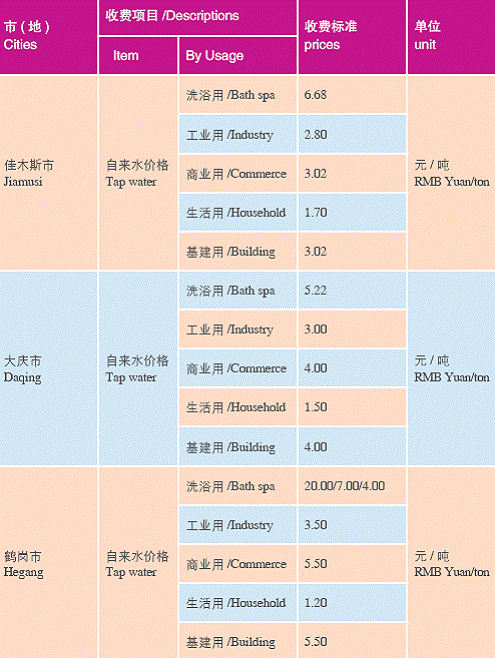
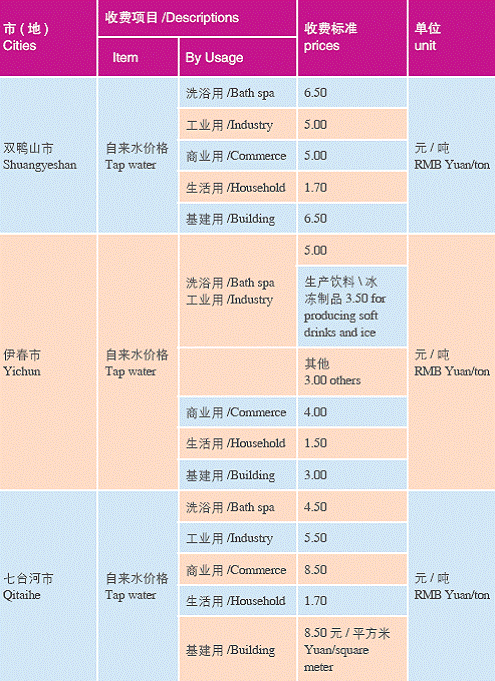

Gas price in different cities in Heilongjiang province

Power price in Heilongjiang Province

IV. Development Zones

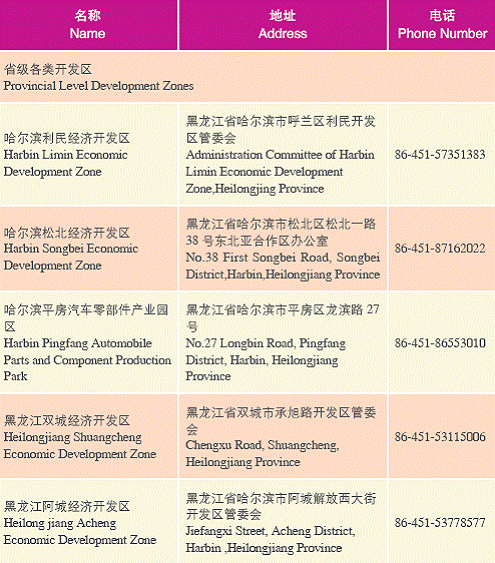

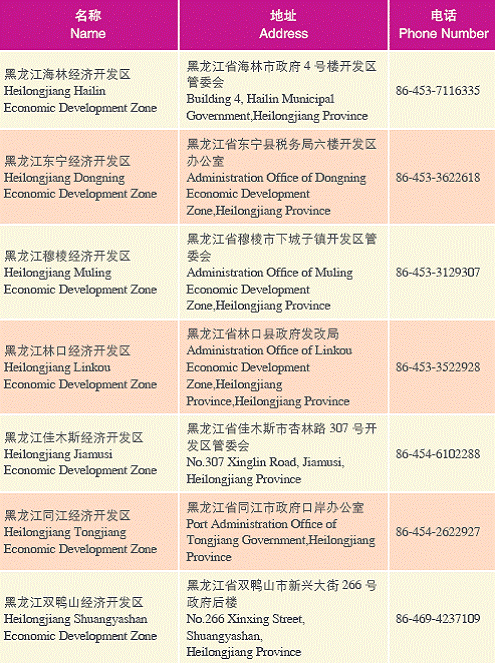

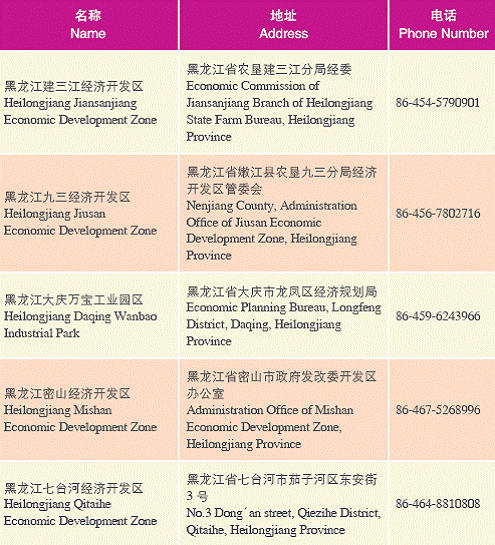
Organizations Concerned
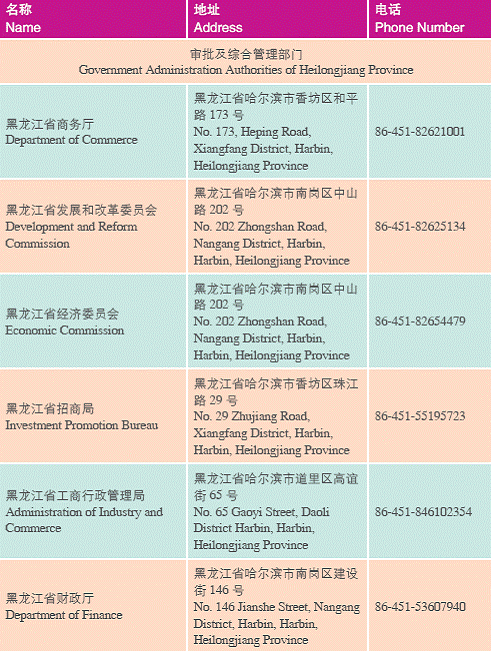
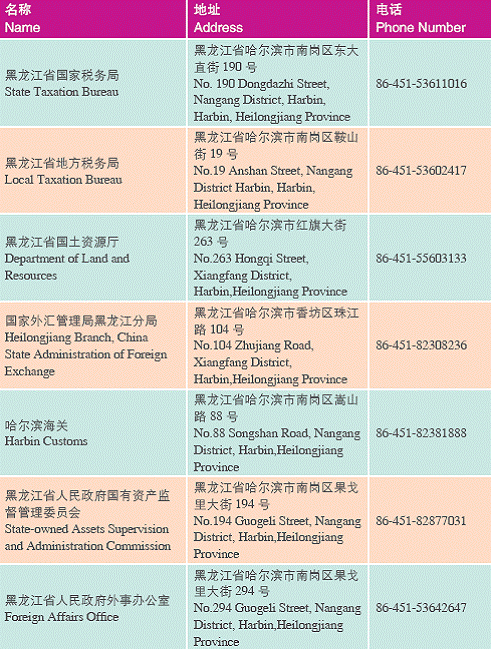
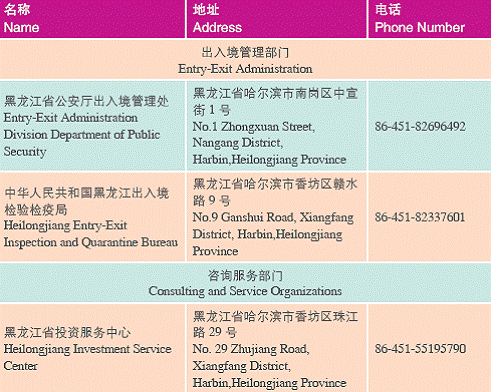

Useful Websites


Appendix
Hotels in Harbin
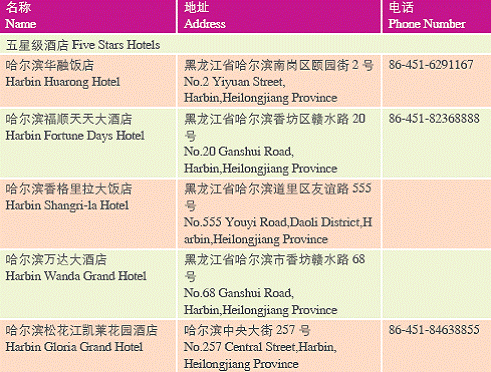
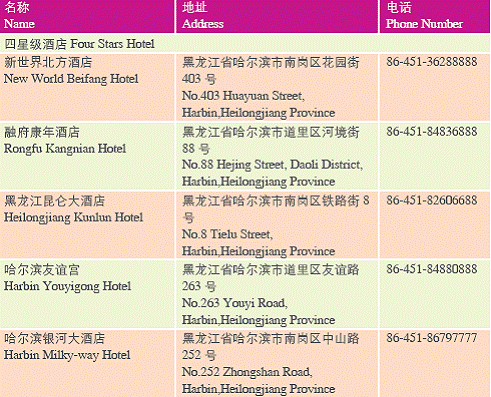
Telephone Numbers for Public Service

(Ministry of Commerce)